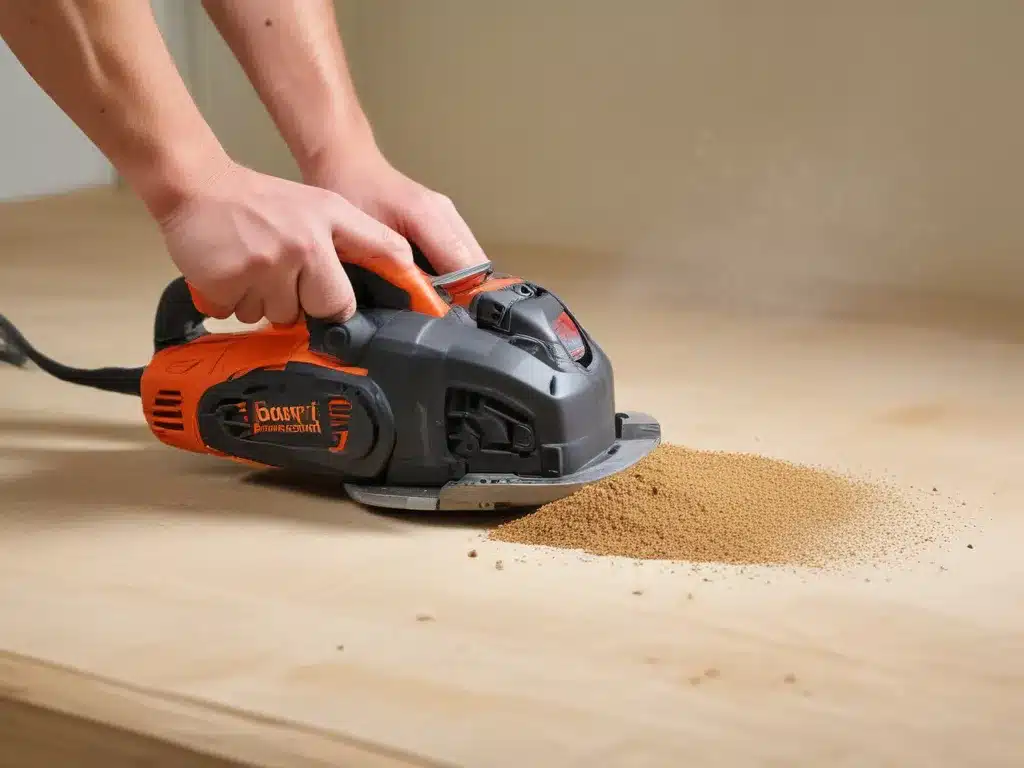
The Dirty Truth About Dust
Ah, the life of a power tool enthusiast. We take great pride in our perfectly calibrated machines, each one a finely-tuned instrument ready to tackle any project that comes our way. But let’s be honest – the downside to all that power and precision? The dust. Oh, the dust! It creeps into every nook and cranny, coating our beloved tools in a thick layer of grime.
I remember the first time I really noticed just how much dust my power tools were accumulating. I was in the middle of a big woodworking project, happily sanding away, when I paused to wipe the sweat from my brow. That’s when I saw it – a fine haze of particles hanging in the air, settling onto every surface. I let out a heavy sigh, knowing that the cleanup was going to be a daunting task.
And it’s not just the aesthetic annoyance of a dusty workshop. That buildup can actually have a serious impact on the performance and longevity of our power tools. Dust can clog air vents, gum up gears and bearings, and even short out sensitive electronic components. Neglect that maintenance, and you might as well be throwing your hard-earned money straight into the trash.
Mastering the Art of Dust Removal
So, how do we keep our power tools in tip-top shape and running at peak efficiency? The key is developing a proactive dust control strategy. It’s all about building good habits and staying on top of regular maintenance.
First and foremost, I make sure to always use the dust collection systems built into my power tools. These handy attachments are designed to capture the majority of airborne particles right at the source, funneling them into a bag or canister for easy disposal. It’s an absolute game-changer, and I don’t know how I ever got by without them.
Of course, even the best dust collection systems have their limits. That’s why I make a point to thoroughly clean and maintain my tools on a regular basis. After every project, I’ll use a combination of compressed air, brushes, and degreasing solvents to meticulously remove any remaining dust and debris. I pay special attention to the air vents, motor housing, and other critical components that can be easily clogged.
And let’s not forget about the workshop environment itself. I make sure to keep my work area as tidy and organized as possible, sweeping and vacuuming frequently to prevent dust from accumulating. I also use high-quality air filtration systems to scrub the ambient air, trapping those pesky particles before they can settle onto my tools.
Customizing Your Dust Control Routine
Now, I know what you’re thinking – that all sounds like a lot of work! And you’re absolutely right. Maintaining a dust-free power tool arsenal is no small feat. But trust me, the payoff is well worth it.
The way I see it, there are a few key factors to consider when developing your own personalized dust control routine:
Tool Usage: How often do you use your power tools, and what kind of projects are you typically working on? The more frequently you’re churning out sawdust and metal shavings, the more diligent you’ll need to be about keeping things clean.
Tool Type: Different power tools present different challenges when it comes to dust management. For example, sanders and grinders tend to be real dust machines, while drills and jigsaws are a bit more contained. Adjust your approach accordingly.
Workshop Layout: The size, layout, and airflow of your workspace can have a big impact on how dust accumulates. An open, well-ventilated shop is going to be much easier to keep clean than a cramped, cluttered one.
Personal Preference: At the end of the day, everyone has their own tolerance level for dust and their own preferred cleaning methods. Some folks might be perfectly content with a quick once-over after each use, while others (like me) prefer a more thorough, scheduled regimen.
The point is, there’s no one-size-fits-all solution. It’s all about finding the right balance of time, effort, and personal preference that works best for you and your power tools. And don’t be afraid to experiment and adjust as you go – the more you practice, the more efficient and effective your dust control routine will become.
The Payoff: Pristine Power Tools and Peak Performance
I’ll admit, keeping my power tools in pristine condition is a bit of an obsession for me. But I can assure you, the effort is more than worth it. When I fire up a perfectly maintained machine, the difference is palpable. The motor runs smoother, the controls feel tighter, and the overall performance is just leagues above a neglected, dust-caked tool.
And let’s not forget about the longevity factor. By protecting my investments from the ravages of dust and debris, I know I’m extending the lifespan of my power tools. That means fewer replacement parts, fewer repairs, and more money stays in my pocket in the long run.
But perhaps the most rewarding aspect of all this is the sense of pride and accomplishment I feel when I look around my pristine workshop. It’s like an extension of my own personal brand – a reflection of the care and attention I put into my craft. And you better believe I take every opportunity to show off my meticulously maintained machines to anyone who steps foot in my shop.
So, if you’re a power tool enthusiast like me, I urge you to make dust control a top priority. Trust me, your tools (and your wallet) will thank you in the long run. Now, if you’ll excuse me, I think it’s time for my weekly workshop deep-clean. Gotta keep those machines running at peak performance, you know!


























